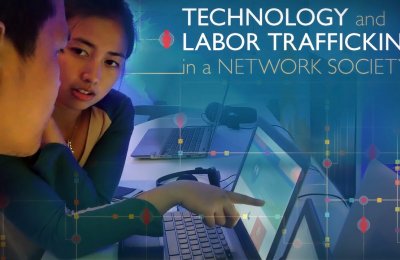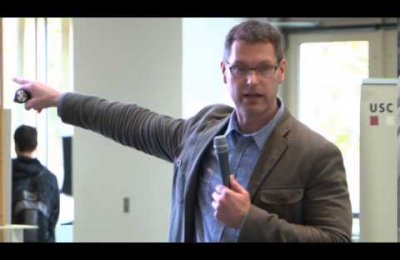By Olivia Niland and Jeremy Rosenberg
A pair of recent talks at USC Annenberg served to further demonstrate the breadth and sophistication of the school's Media, Economics & Entrepreneurship, or M{2e}, initiative.
On March 27 (view photos), economist, venture capitalist and author William H. Janeway visited the school to speak about his recent book, Doing Capitalism in the Innovation Economy: Markets, Speculation and the State.
Then on April 15 (photos), Mitchel Y. Abolafia, a professor at the Rockefeller College of Public Affairs and Policy, University at Albany/ SUNY, made a presentation titled, “Fine-tuning the Signal: Image and Identity at the Federal Reserve.”
Both of the talks were part of the M{2e} research series, “Media, Money, and Society.”
Janeway's lecture, “What I Learned by Doing Capitalism,” addressed many of the main points of his 2012 book, which argues that the "Innovation Economy" is stalled and in dire need of revival.
Janeway works as senior advisor for technology, media and telecommunications at private equity firm, Warburg Pincus. He also teaches at Princeton University and is a visiting scholar at Cambridge University.
At USC Annenberg, Janeway opened his lecture with a definition of the Innovation Economy, which is the subject of Doing Capitalism and one of the areas of research for which he is best known. “It begins with discovery and culminates in speculation,” Janeway said, citing inventions such as canals and the internet—which have been costly to create but invaluable in their usefulness—as examples of innovations that have transformed America's market economy over the past 250 years.
According to Janeway, in order for the Innovation Economy to be successful, profit shouldn't be the primary motivating factor. “At each stage," he said, "the Innovation Economy depends on sources of funding that are decoupled from concern for economic return.”
Janeway's lecture focused largely upon his research of U.S. venture capitalism during the past few decades, including the height of its success at the end of the twentieth century. The lecture also highlighted financial booms and busts such as the dotcom/telecom bubble of 1999-2000.
As is typical with any bubble, Janeway said, investors in the dotcom boom were driven by the hope that they would be able to cash in on their investments before having to find out their true value. “Venture capital is a craft, not an industry,” Janeway said.
Janeway's lecture was followed by a response from economics professor Alexander J. Field of Santa Clara University, titled “A Great Leap Forward: 1930's Depression and US Economic Growth,” as well as a discussion session that included USC Annenberg communication professors Christopher Smith and Jonathan Aronson.
Smith, along with USC Annenberg journalism professor Gabriel Kahn, are the M{2e} co-directors. (For more information about M{2e}, visit this page.)
If Janeway's lecture was in part about how market speculation can be "catastrophic" for the economy, then Abolafia's remarks were in part about another sort of conjecture.
Thanks to the Freedom of Information Act, Abolafia gained access to what he characterized during his USC Annenberg talk in the Geoffrey Cowan Forum as "a treasure trove" of transcripts of the behind-the-scenes conversations of the twelve members of the Federal Reserve's Federal Open Market Committee (FOMC).
The Fed's public communications are – to say the least – closely watched and carefully parsed and scrutinized by a wide range of interested parties. Why? Because the Fed sets interest rates. "And in doing this," Abolafia said, "They shape the expansion and contraction of the economy."
Adds Abolafia: "There is real fear about misinterpretations of the Fed's intentions."
Public signaling is one thing, but what about the private discussions of FOMC members? Do the sometimes opaque, other times transparent pronouncements of various Fed chairmen and board members over the years match up with what those same people are saying in private? And what other communication "fine-tuning" occurs during these periodic sessions?
"One has to be impressed as you listen to how aware they are of the impact of their decisions," Abolafia said. "They take it very, very seriously."
Little had been previously known about the specifics of the Fed hierarchy's internal deliberations. Abolafia has in hand the verbatim transcripts of FOMC meetings held between 1978 and 2007 – a span that includes five different Fed leaders as well as many American and global economic upturns and downturns.
"The Fed’s effectiveness is dependant on its creditability," Abolafia said, noting that elsewhere, the opposite is usually true and that credibility depends on effectiveness.
If, for example, Fed-watchers believe that the body will keep its word regarding keeping interest rates close to zero percent until 2015, then the managers of and participants in various sectors of the economy will act accordingly.
Abolafia amused his audience – as intended – when he showed PowerPoint images of actor Tom Cruise and previous Fed chairman, Alan Greenspan. The professor asked what does the Hollywood actor and the Fed have in common? The answer? "Both care deeply about image."
Abolafia also asked his USC Annenberg audience to chime in with observations related to organizational transparency. "There is an inherent conflict between democracy and bureaucracy," the professor said.
Watch videos of other M{2e} talks.
Follow M{2e} on Twitter.








